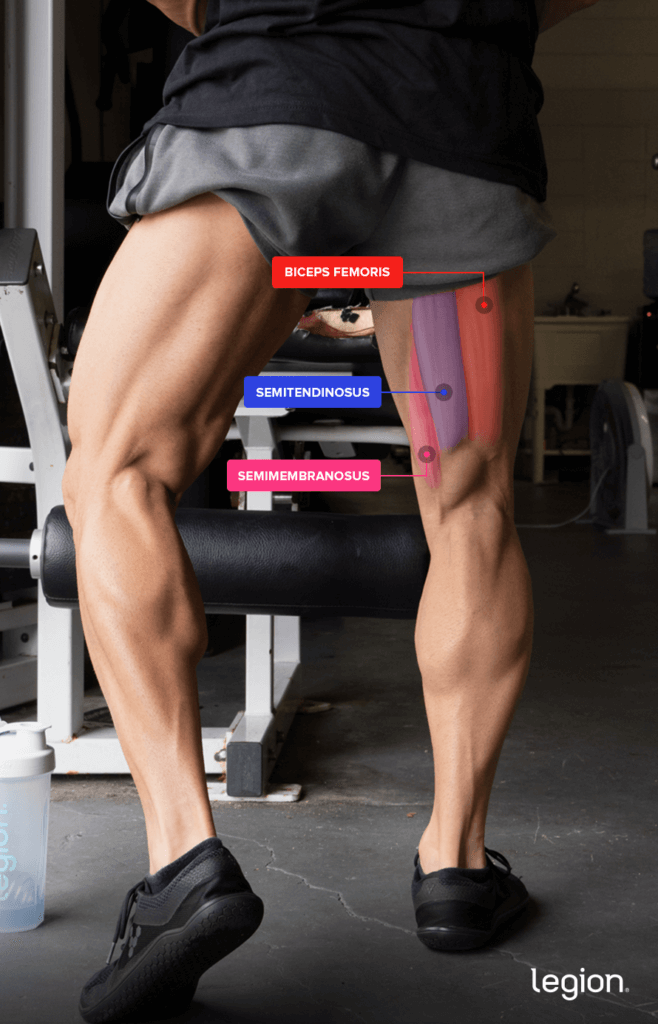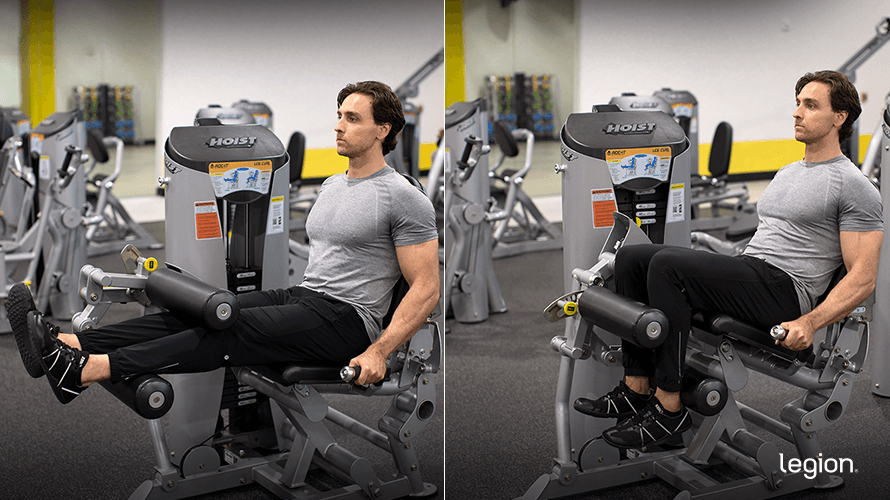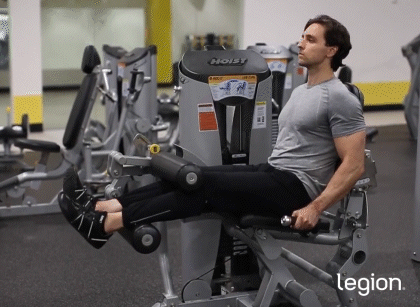The leg curl is a hamstring exercise, typically performed on a leg curl machine.
It’s unique among hamstring exercises because it trains your hamstrings through a full range of motion while fully stretched, which makes it ideal for building muscle.
In this article, you’ll learn what the leg curl is, its benefits, which muscles it works, how to do it with proper form, the best seated leg curl alternatives, and more.
What Is the Leg Curl?
The leg curl is a lower-body exercise that primarily trains the hamstrings and involves bending your knees to bring your feet closer to your butt against resistance.
There are two main variations of the leg curl: The seated leg curl and the lying leg curl. You can perform both using various pieces of equipment, though most people prefer to use a leg curl machine.
Seated Leg Curl vs. Lying Leg Curl: Which Is Better?
The main difference between the seated leg curl and the lying leg curl is how you position your body. To perform a seated leg curl, you sit upright on a seated leg curl machine with your legs outstretched. To perform the lying leg curl, you lie face down on a lying leg curl machine.
While this difference seems innocuous, it significantly changes how the exercise trains your hamstrings.
That’s because sitting upright with your legs straight in front of you places your hamstrings in a fully stretched position, whereas lying down doesn’t. This is noteworthy because research shows that when it comes to building muscle, training a muscle while it’s stretched is superior to training it while it’s relaxed.
And that’s why studies show doing the seated leg curl leads to more muscle growth than doing the lying hamstring curl. Thus, most people will benefit more from the seated leg curl than the lying leg curl, which is why the seated leg curl is the variation we’ll focus on in this article.
That said, the lying leg curl is still an effective exercise. If you prefer how it feels or it’s the only machine you have access to, it’s a viable alternative.
Leg Curl: Benefits
The hamstrings have two primary functions: knee flexion (bending your knee) and hip extension (moving your torso away from your thighs).
One of the main benefits of the leg curl is it trains knee flexion, something most other hamstring exercises (all forms of the deadlift, the hip thrust, and the glute bridge, for example) neglect.
Furthermore, the seated leg curl trains knee flexion while the three largest “parts” of the hamstrings—the long head of the biceps femoris, semitendinosus, and semimembranosus—are fully lengthened. This makes it particularly effective for developing the areas of the hamstrings that have the biggest impact on upper-leg size.
Another benefit of the leg curl is that it allows you to train your hamstrings when your back is tired.
This is important because during most exercises that train the hamstrings, such as the deadlift, Romanian deadlift, and squat, your back muscles have to work hard to keep your upper body in a stable and safe position.
If your lower-body workouts only consist of free-weight exercises like these, your back muscles (and particularly your lower-back muscles) may fatigue faster than your hamstrings. While your back may be bushed after 6 sets of these exercises, your hamstrings may be able to handle a few more.
The leg curl is a helpful workaround in this scenario. It allows you to train your hamstrings after your back is fried, ensuring you can train your hammies with the volume they need to grow and become stronger without your lower back becoming a limiting factor.
For these reasons, I always include the leg curl in my own training and my fitness programs for men and women, Bigger Leaner Stronger and Thinner Leaner Stronger.
And if you’d like more specific advice about what exercises to include in your training program to reach your health and fitness goals, take the Legion Strength Training Quiz, and in less than a minute, you’ll know the perfect strength training program for you. Click here to check it out.
Seated Leg Curl: Muscles Worked
The leg curl primarily trains the hamstrings, though it also trains the glutes and calves to a small degree, too.
Here’s how the main muscles worked by the leg curl look on your body:

How to Do the Leg Curl
The best way to learn how to do the leg curl is to split the exercise into three parts: set up, curl, and extend.

Step 1: Set Up
Sit on the seated leg curl machine so the backs of your knees are a couple of inches off the pad supporting your thighs.
Adjust the heel pad so it’s across your Achilles tendons, then grab the handles and pull yourself down so that your butt is wedged into the base of the seat and your back is against the backrest.
Step 2: Curl
Without lifting your butt off the seat or leaning forward, press your heels toward your butt until your shins are roughly perpendicular to your thighs (or closer).
Step 3: Extend
Once your shins are roughly perpendicular to your thighs, straighten your knees and return to the starting position. Don’t try to extend your knees slowly. The entire “extension” should be controlled but only take about a second.
Here’s how it should look when you put it all together:

The Best Seated Leg Curl Alternatives
1. Lying Leg Curl
The lying leg curl trains the hamstrings similarly to the seated leg curl. The only difference is the seated variation places the hamstrings in a more stretched position, which is generally better for muscle growth. While the lying leg curl probably isn’t quite as effective as the seated leg curl for developing your hamstrings, it’s still an excellent seated leg curl alternative if your gym doesn’t have a seated leg curl machine or if you’ve been doing the seated version for a while and want to mix up your training.
2. Nordic Leg Curl
Research shows that the Nordic leg curl is a fantastic bodyweight exercise for training your hamstrings, which may also reduce your risk of suffering a hamstring injury. While it isn’t exactly the same as the seated leg curl, you can use it as an alternative to the seated leg curl at home.
3. Dumbbell Leg Curl
The dumbbell leg curl is similar to the lying leg curl, except you grasp a dumbbell between your feet instead of using a leg curl machine. The dumbbell leg curl can be a useful seated leg curl alternative in a bind, but most people find it awkward to set up and perform. Thus, it’s not a variation I’d recommend unless you don’t have access to a leg curl machine (while working out at home or traveling, for example).
4. Swiss Ball Leg Curl
The benefit of the Swiss ball leg curl is that it requires minimal equipment and space to perform. However, it’s also deceptively difficult because it requires a lot of balance and coordination. As such, the Swiss ball leg curl probably isn’t the best option for someone who’s new to strength training, though it may be a good alternative for more experienced weightlifters who like to train at home.
Scientific References +
- Oranchuk, D. J., Storey, A. G., Nelson, A. R., & Cronin, J. B. (2019). Isometric training and long-term adaptations: Effects of muscle length, intensity, and intent: A systematic review. Scandinavian Journal of Medicine & Science in Sports, 29(4), 484–503. https://doi.org/10.1111/SMS.13375
- Maeo, S., Wu, Y., Huang, M., Sakurai, H., Kusagawa, Y., Sugiyama, T., Kanehisa, H., & Isaka, T. (2022). Triceps brachii hypertrophy is substantially greater after elbow extension training performed in the overhead versus neutral arm position. European Journal of Sport Science. https://doi.org/10.1080/17461391.2022.2100279
- Maeo, S., Huang, M., Wu, Y., Sakurai, H., Kusagawa, Y., Sugiyama, T., Kanehisa, H., & Isaka, T. (2021). Greater Hamstrings Muscle Hypertrophy but Similar Damage Protection after Training at Long versus Short Muscle Lengths. Medicine and Science in Sports and Exercise, 53(4), 825–837. https://doi.org/10.1249/MSS.0000000000002523
- Yanagisawa, O., & Fukutani, A. (2020). Muscle Recruitment Pattern of the Hamstring Muscles in Hip Extension and Knee Flexion Exercises. Journal of Human Kinetics, 72(1), 51–59. https://doi.org/10.2478/HUKIN-2019-0124
- Rodgers, C. D., & Raja, A. (2022). Anatomy, Bony Pelvis and Lower Limb, Hamstring Muscle. StatPearls. https://www.ncbi.nlm.nih.gov/books/NBK546688/
- STEVENS, B. M., NICHOLS, B. R., DOTY, H. I., & KORAK, J. A. (2022). Muscle Activation Patterns of the Proximal Medial and Distal Biceps Femoris and Gluteus Maximus Among 6 Hip Extension and Knee Flexion Exercises in Trained Women. International Journal of Exercise Science, 15(1), 1179. /pmc/articles/PMC9362892/
- Snarr, R., & Esco, M. R. (2014). Lying hamstring curl with a dumbbell. Strength and Conditioning Journal, 36(2), 82–84. https://doi.org/10.1519/SSC.0000000000000038
- Ebben, W. P. (2009). Hamstring activation during lower body resistance training exercises. International Journal of Sports Physiology and Performance, 4(1), 84–96. https://doi.org/10.1123/IJSPP.4.1.84
- Marchiori, C. L., Medeiros, D. M., Severo-Silveira, L., dos Santos Oliveira, G., Medeiros, T. M., de Araujo Ribeiro-Alvares, J. B., & Baroni, B. M. (2022). Muscular adaptations to training programs using the Nordic hamstring exercise or the stiff-leg deadlift in rugby players. Sport Sciences for Health, 18(2), 415–423. https://doi.org/10.1007/S11332-021-00820-0/METRICS
- Cuthbert, M., Ripley, N., McMahon, J. J., Evans, M., Haff, G. G., & Comfort, P. (2020). The Effect of Nordic Hamstring Exercise Intervention Volume on Eccentric Strength and Muscle Architecture Adaptations: A Systematic Review and Meta-analyses. Sports Medicine (Auckland, N.Z.), 50(1), 83. https://doi.org/10.1007/S40279-019-01178-7










